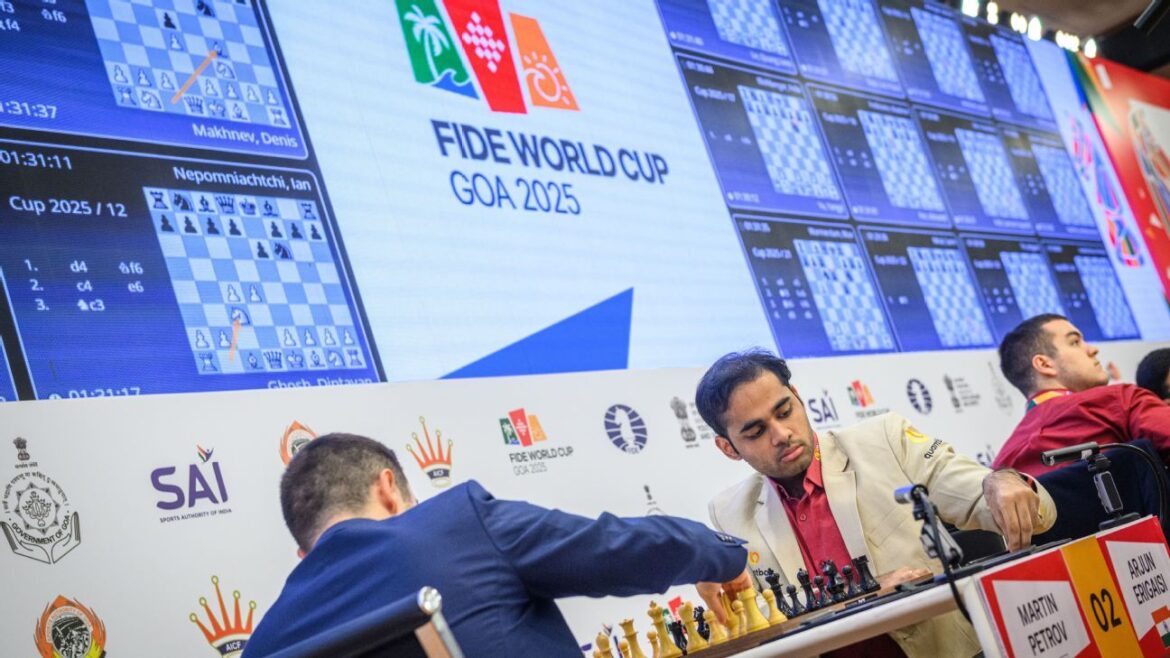India’s campaign at the FIDE World Cup 2025 in Goa came to an abrupt halt in the quarterfinals, as Arjun Erigaisi, the last remaining Indian in the field, lost in tie-breaks to China’s Wei Yi.
It’s a crushing blow for Erigaisi, who now cannot qualify for the 2026 FIDE Candidates tournament. His World Championship dream now stands pushed back by at least two years.
Ironically, it was Erigaisi’s desire in the tie-breaks to win the game within the first set of rapid games that caused his downfall. That’s the opinion of Wei Yi, who said that Erigaisi over pushed in a position that wasn’t conducive for it and then ended up making a mistake by pushing his rook to f2 for a check on move 41.
���� Wei Yi reaches the semifinals after a 2.5-1.5 victory over Arjun Erigaisi ����#FIDEWorldCup #Goa pic.twitter.com/8mlKjxVYDe
– International Chess Federation (@FIDE_chess) November 19, 2025
However, the larger picture is of a failure for the Indian men at this tournament. In fact, the Indians haven’t come close to winning at the year’s two biggest tournaments of the year – the FIDE Grand Swiss being the other – and that must lead to some introspection. This means that while there are three Indians at the women’s Candidates, there will likely only be one – Praggnanandhaa Rameshbabu – in the Open section at the Candidates.
At the Grand Swiss in September, Erigaisi was the highest-placed Indian finisher at 6th, with Nihal Sarin 9th, Vidit Gujrathi 15th, Praggnanandhaa 35th and world champion Gukesh Dommaraju 41st.
At this World Cup, meanwhile, there were 24 Indians at the start, but the final four will have none. In fact, the final eight had just one, the final 16 two, and the final 32 five. Those are numbers that will irk these young stars of Indian chess. They’ve got a taste for performing at the highest level and have shown the ability to win these big events, but when you do it once, you’re expected to go on and do it again, and again. And again. That’s what made the likes of Viswanathan Anand and Magnus Carlsen the greats that they are.
So, what happened here?
GM Srinath Narayanan, the captain of the Indian Olympiad Team, tells ESPN that with just one game with each colour in each round, variance is to be expected. It’s only natural, and that shouldn’t be a metric to draw long-term conclusions from, Srinath argues.
Srinath, who assisted both Vidit Gujrathi and Pentala Harikrishna at this tournament, likens this World Cup format to a tennis grand-slam being one set affairs instead of best-of-fives. He called for the number of tie-break games to be increased to at least four so players have two rotations with each colour. Then, he argued, the superior players would show their superiority more often. As it stands, the variance this format brings must just be accepted.
And there was a lot of variance. Frederik Svane, who beat Gukesh in the third round, had an ELO of 2638 when this tournament began. Daniil Dubov, who beat Praggnanandhaa in the fourth round, had an ELO of 2684 when the tournament began. Nihal Sarin lost in the second round to Nikolas Theodorou, who was 2652-rated when the tournament began.
In a way, it was a role-reversal from the 2023 World Cup in Baku, when Praggnanandhaa made the final despite being seeded 31st, and Erigaisi made the quarterfinal as the 23rd seed. There is enough evidence, then, from the past that the World Cup does not care for seeding or reputation. You need to perform on the day, every day, across seven rounds, if you want to win the tournament. It’s perhaps the most gruelling tournament on the calendar to win. So, to come into that on the back of having played the amount of chess that the likes of Gukesh, Praggnanandhaa and Erigaisi have played throughout the year was certainly a factor in an underwhelming performance, Srinath says.
“The schedule is absolutely insane,” he says, “and that has certainly caught up with them, especially Pragg.”
It’s an argument that explains how the Indians came apart in the two big tournaments of the year, both of which happened in the back end of it. By then, across big invitational classical tournaments, the Grand Chess Tour, and the Freestyle Chess Tour, the big three had all played way too much chess. This does, though, beg the question of planning – perhaps now is the right time to introspect, and plan schedules to help these young athletes peak at the biggest events of the season.
Next year will once again be a huge year, with the Olympiad in Uzbekistan and the World Championship match (that could yet be fought between two Indians), and if there’s one thing 2025 has taught Indian chess it is that focused planning will be essential. For winners or not, talented or not, there are no divine rights enshrined in sport. 2025 was a reminder that if you’re not at your absolute best, there are enough opponents around who are good enough to take advantage.
So, just as on November 19 a couple of years ago, another November 19 has come and taken with it an Indian dream of winning a home World Cup. The wait for a first Indian men’s World Cup winner since the great Anand goes on.
